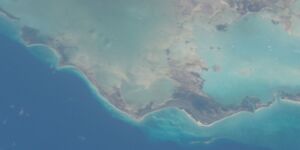East German-Molossian War
| East German-Molossian War | |||||||
|---|---|---|---|---|---|---|---|
| |||||||
| Belligerents | |||||||
|
| |||||||
| Commanders and leaders | |||||||
|
| None (de facto) | ||||||
The East German-Molossian War (German: Ostdeutsch-Molossischer Krieg), also known in Molossia as the War with East Germany, is an ongoing war that was declared by the Grand Republic of Vuldstein (modern-day Molossia) against East Germany.
History
Declaration of war
On 2 November 1983, the government of Vuldstein (modern-day Molossia) declared war against the German Democratic Republic, better known as East Germany, alleging that they were responsible for military drills performed by Kevin Baugh while stationed with the United States Military in West Germany, and therefore are also "responsible for the resulting lack of sleep of Kevin Baugh."[1][2] The war declaration was eventually ignored by East Germany until its reunification with the Federal Republic of Germany (then known as West Germany).
Rediscovery of declaration

In September 2008, the Molossian government rediscovered several documents during the Vuldstein era, among these are the declaration of war against East Germany. While the East Germany was dissolved after the reunification with West Germany in 1990 via the Treaty on the Final Settlement and thus ceased to exist, the Molossian government argues that the Cuban island Cayo Blanco del Sur, through dedication by the Cuban government by renaming the island to Weimar German communist politician Ernst Thälmann during a diplomatic visit of East German politicians in 1972 (which believed that Cuba gave the island to the East German authority, though the act is "purely symbolic" by Germany and Cuban authorities)[3] and lack of mention of the island in the Treaty on the Final Settlement or by the nation of Cuba either, is the last remaining East German territory, allowing for the war to continue.[4] [5]
Recent History
In 2009, Vikesland (an ally of Molossia) visited Ernst Thälmann Island and found an East German flag there. Through this discovery, the Molossian government claimed that East Germany was "still operating long after its demise."[6] [7]
As of 2023, the war is still ongoing and there are no plans to end the war by the Molossian government, several claimants of the now-defunct East German government, including New East Germany, attempted to negotiate with the Molossian government, which was mostly ignored by Molossia with a rare exception on 18 July 2020, a group of people who claimed to represent East Germany visited Molossia to request the end of the war. However, Kevin Baugh "emphatically declined" their request due to a "variety of reasons".[8]
References
- ↑ "The War with East Germany". Molossia.org. Retrieved 2017-10-18.
- ↑ Machado, Carmen (2013-04-26). "The Imaginary Republic of Molossia". VICE. Retrieved 2017-10-18.
- ↑ Martin, Nik (27 November 2016). "Castro's Caribbean island gift to East Germany". DW. Retrieved 22 June 2023.
- ↑ "The War with East Germany". Molossia.org. Retrieved 2017-10-18.
- ↑ Rewboss (2 October 2017). "East Germany lives on [Video]". YouTube. Retrieved 22 June 2023.
- ↑ "The War with East Germany". Molossia.org. Retrieved 2017-10-18.
- ↑ Vikeslandic Broadcasting System (22 February 2009). "Thallmann Island, Vikesland/Molossia naval mission. [Video]". YouTube. Wheatcityfilms. Retrieved 22 June 2023.
- ↑ "TOURISTS, EAST GERMANS AND YES THEORY". Khasmin Molossia News. Retrieved 2021-07-07.
External links
- The War with East Germany - information regarding the conflict in Molossian perspective.
| This page uses content from Wikipedia. The original article was at Republic of Molossia. The list of authors can be seen in the page history. |